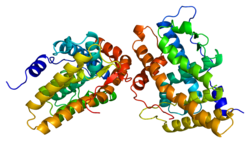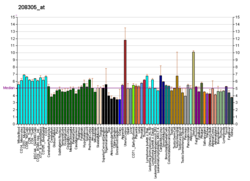Cytochrome p450 family 19 subfamily a member 1
Cytochrome P450 family 19 subfamily A member 1 is a protein that in humans is encoded by the CYP19A1 gene. [5]
Function
This gene encodes a member of the cytochrome P450 superfamily of enzymes. The cytochrome P450 proteins are monooxygenases which catalyze many reactions involved in drug metabolism and synthesis of cholesterol, steroids and other lipids. This protein localizes to the endoplasmic reticulum and catalyzes the last steps of estrogen biosynthesis. Mutations in this gene can result in either increased or decreased aromatase activity; the associated phenotypes suggest that estrogen functions both as a sex steroid hormone and in growth or differentiation. Alternative promoter use and alternative splicing results in multiple transcript variants that have different tissue specificities. [provided by RefSeq, Dec 2016].
References
- ^ a b c GRCh38: Ensembl release 89: ENSG00000137869 – Ensembl, May 2017
- ^ a b c GRCm38: Ensembl release 89: ENSMUSG00000032274 – Ensembl, May 2017
- ^ "Human PubMed Reference:". National Center for Biotechnology Information, U.S. National Library of Medicine.
- ^ "Mouse PubMed Reference:". National Center for Biotechnology Information, U.S. National Library of Medicine.
- ^ "Entrez Gene: Cytochrome P450 family 19 subfamily A member 1". Retrieved 2018-06-07.
Further reading
- Comings DE, Gade-Andavolu R, Gonzalez N, Wu S, Muhleman D, Blake H, Mann MB, Dietz G, Saucier G, MacMurray JP (November 2000). "A multivariate analysis of 59 candidate genes in personality traits: the temperament and character inventory". Clin. Genet. 58 (5): 375–85. doi:10.1034/j.1399-0004.2000.580508.x. PMID 11140838. S2CID 14733771.
- Baxter SW, Choong DY, Eccles DM, Campbell IG (February 2001). "Polymorphic variation in CYP19 and the risk of breast cancer". Carcinogenesis. 22 (2): 347–9. doi:10.1093/carcin/22.2.347. PMID 11181459.
- Berstein LM, Imyanitov EN, Suspitsin EN, Grigoriev MY, Sokolov EP, Togo A, Hanson KP, Poroshina TE, Vasiljev DA, Kovalevskij AY, Gamajunova VB (February 2001). "CYP19 gene polymorphism in endometrial cancer patients". J. Cancer Res. Clin. Oncol. 127 (2): 135–8. doi:10.1007/s004320000200. PMID 11216915. S2CID 31884230.
- Tucci S, Futterweit W, Concepcion ES, Greenberg DA, Villanueva R, Davies TF, Tomer Y (January 2001). "Evidence for association of polycystic ovary syndrome in caucasian women with a marker at the insulin receptor gene locus". J. Clin. Endocrinol. Metab. 86 (1): 446–9. doi:10.1210/jcem.86.1.7274. PMID 11232039.
- Masi L, Becherini L, Gennari L, Amedei A, Colli E, Falchetti A, Farci M, Silvestri S, Gonnelli S, Brandi ML (May 2001). "Polymorphism of the aromatase gene in postmenopausal Italian women: distribution and correlation with bone mass and fracture risk". J. Clin. Endocrinol. Metab. 86 (5): 2263–9. doi:10.1210/jcem.86.5.7450. PMID 11344237.
- Latil AG, Azzouzi R, Cancel GS, Guillaume EC, Cochan-Priollet B, Berthon PL, Cussenot O (September 2001). "Prostate carcinoma risk and allelic variants of genes involved in androgen biosynthesis and metabolism pathways". Cancer. 92 (5): 1130–7. doi:10.1002/1097-0142(20010901)92:5<1130::aid-cncr1430>3.0.co;2-b. PMID 11571725.
- Modugno F, Weissfeld JL, Trump DL, Zmuda JM, Shea P, Cauley JA, Ferrell RE (October 2001). "Allelic variants of aromatase and the androgen and estrogen receptors: toward a multigenic model of prostate cancer risk". Clin. Cancer Res. 7 (10): 3092–6. PMID 11595700.
- Bulun SE, Yang S, Fang Z, Gurates B, Tamura M, Zhou J, Sebastian S (December 2001). "Role of aromatase in endometrial disease". J. Steroid Biochem. Mol. Biol. 79 (1–5): 19–25. doi:10.1016/s0960-0760(01)00134-0. PMID 11850203. S2CID 7642211.
- Chen S, Zhou D, Yang C, Okubo T, Kinoshita Y, Yu B, Kao YC, Itoh T (December 2001). "Modulation of aromatase expression in human breast tissue". J. Steroid Biochem. Mol. Biol. 79 (1–5): 35–40. doi:10.1016/s0960-0760(01)00132-7. PMID 11850205. S2CID 33879090.
This article incorporates text from the United States National Library of Medicine, which is in the public domain.





